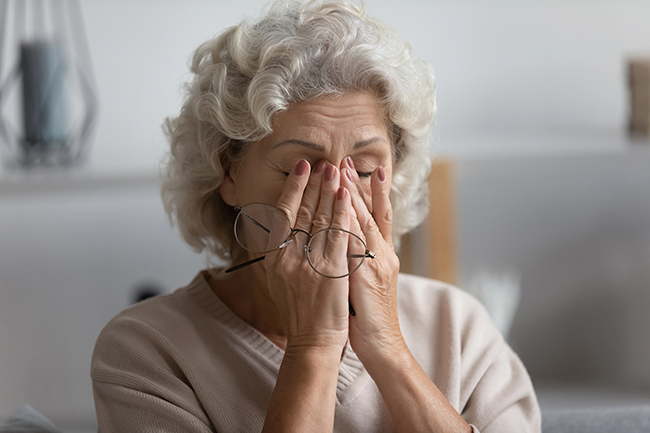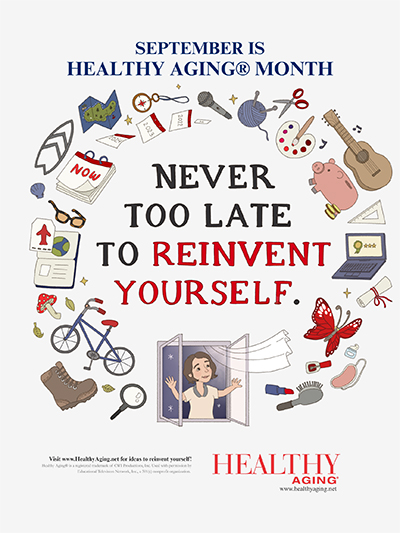This article is sponsored by Bausch + Lomb and is intended for educational purposes. It does not constitute medical advice. Please consult your doctor for personalized care.
September is Healthy Aging® Month – the perfect time to learn about dry eye, a common, often overlooked condition that could be interfering with your daily life.

Aging comes with new opportunities and unique, amazing experiences. From balancing a busy career to enjoying a new hobby in retirement, becoming an empty nester, or enjoying time in the garden. And while things may start to look a little bit different, life isn’t slowing down. This time – full of fresh adventures and shifts to your lifestyle – likely also comes with changes to your health, but these don’t have to hold you back. If you’re finding that dry, tired, itchy or burning eyes are getting in your way, you are far from alone.
Approximately 38 million Americans are affected by what is called chronic dry eye, also known as dry eye disease, where persistent symptoms such as blurriness, stinging or discomfort keep coming back and may worsen over time. While this can become increasingly prevalent as you age, chronic dry eye is frequently overlooked.

Dry eye is often brushed off as just another part of aging, but the truth is, having persistent symptoms isn’t normal, and inflammation may be at the root of your symptoms, but the good news is, there’s something you can do about it.
So, what causes chronic dry eye, really?
There are several everyday factors that can influence symptoms, including prolonged contact lens wear, increased screen time, medications, hormonal changes, age or even the environment. Dry eye is more common for those with preexisting inflammatory health issues, like autoimmune conditions or diabetes, and inflammation may be a systemic issue that also impacts the eyes.
There are multiple types of dry eye with varying causes, but for many, underlying inflammation may be at the root. In fact, up to 65% of people have clinically significant inflammation. Dry eye can become a chronic cycle in which continued drying and friction when blinking can damage the surface of the eye and further trigger inflammation, making symptoms worse.
How can I manage my dry eye?
Living with these symptoms day in and day out can impact many aspects of your life. You may feel like you’ve tried everything when it comes to over-the-counter (OTC) eye drops, but they may not be providing long-term relief; it could be because inflammation is the cause behind the pesky and persistent symptoms. Not all eye drops work the same way, and while OTC drops may pause dry eye symptoms temporarily, they don’t target the underlying issues, like inflammation.

If underlying inflammation is a driver for your dry eye or inflammation is at the root of your dry eye symptoms, it may be time to talk to your doctor about prescription treatment options like XIIDRA® (lifitegrast ophthalmic solution) 5%. XIIDRA is a prescription eye drop used to treat the signs and symptoms of dry eye disease and designed to offer lasting relief by targeting the cause of your dry eye symptoms. With twice-daily use, XIIDRA – the only nonsteroid anti-inflammatory prescription option – fits into your busy routine as easily as brushing your teeth morning and night.
Okay, but do I really need a prescription for chronic dry eye?
While a prescription treatment might not be right for everyone, if you’re constantly using OTC eye drops and still experiencing symptoms, it might be the best option for you. In fact, chronic dry eye is a serious condition that, if left untreated, can cause damage to your eyes. According to the 2025 State of Dry Eye survey, 78% of those who switched from an OTC to a prescription say they wish they had done so sooner, and 88% of dry eye sufferers who use a prescription treatment wished they had started it sooner.1
Chronic dry eye isn’t just a minor annoyance or another part of simply aging. It can make things like traveling, exercising, reading or working all the more difficult. September is Healthy Aging® Month, a perfect time to take action for your eye health, and by directly targeting your dry eye inflammation, you can get to the root of your symptoms.

Don’t let the misconception that dry eye is just a normal part of aging keep you from seeking relief. Talk to your eye doctor to see if XIIDRA is right for you or visit XIIDRA.com to learn more.
Indication
Xiidra (lifitegrast ophthalmic solution) 5% is a prescription eye drop used to treat the signs and symptoms of dry eye disease.
Important Safety Information
- Do not use Xiidra if you are allergic to any of its ingredients. Seek medical care immediately if you get any symptoms of an allergic reaction.
- The most common side effects of Xiidra include eye irritation, discomfort or blurred vision when the drops are applied to the eyes, and an unusual taste sensation.
- To help avoid eye injury or contamination of the solution, do not touch the container tip to your eye or any surface. If you wear contact lenses, remove them before using Xiidra and wait for at least 15 minutes before placing them back in your eyes.
- It is not known if Xiidra is safe and effective in children under 17 years of age.
You are encouraged to report negative side effects of prescription drugs to the FDA. Visit www.fda.gov/medwatch/, or call 1-800-FDA-1088.
For additional safety information, click here for Full Prescribing Information and Patient Information and discuss with your doctor.
1 The 2025 State of Dry Eye Harris Poll surveyed 732 U.S. adults aged 18 or older who often/always experience eye dryness and/or have been diagnosed by a healthcare professional with dry eye disease (referred to as “sufferers of dry eye”) on their experiences with dry eye and relief options. Of those 347 disclosed taking only an over-the-counter product and 385 disclosed taking a prescription medication for their dry eye. ↩︎ Back to text
All photos: Deposit Photos











